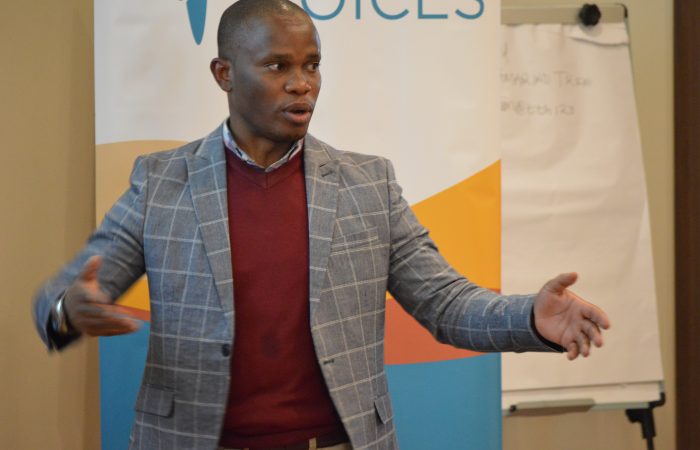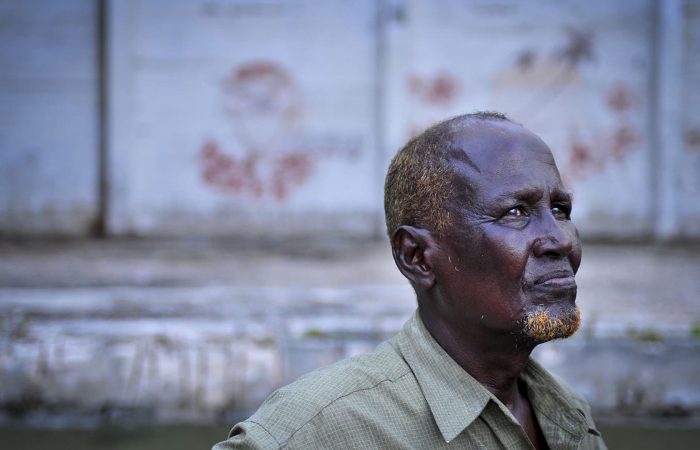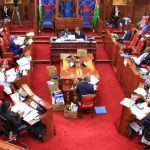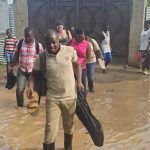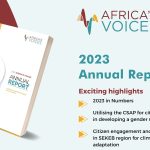It’s April 2017, and DJ Bling and Bonoko at Ghetto Radio, Nairobi, are on air discussing the challenges faced by school-going girls while on their period. They are joined by a guest, Teresa, who is a trained counsellor on Sexual and Reproductive Health issues working with LVCT Health. They have been reading out the following scenario to the audience and inviting them to respond via SMS to a toll-free number:
“Trish is a Form 1 student in your neighbourhood. She has been having trouble attending school when she has her period due to strong menstrual pains and fear of soiling her uniform. She is considering not going to school. Do you think Trish should go to school during her period? Yes or No? Why?”

Teresa on the far left and Bonoko on the far right. Deborah from Africa’s Voices in the middle.
As text messages from the radio audience stream in, through the Echomobile SMS platform, DJ Bling reads them out to spark engagement and discussion.
Audience message: “Do monthly periods come in different types as some people complain of pain while others don’t?”
Teresa: “Different girls experience periods in different ways. There are those that may not have any pain while there are those that have very severe pain, while others have light flows and others have very heavy flows…”
DJ Bling turns to Bonoko to ask for his opinion on the topic, and Bonoko responds by laughing, exclaiming and shaking his head profusely: “Eh! Eh! Eh! Oh! Oh! Oh! Nooooo! I have no clue! I am learning a lot today!”

Bonoko on the far left, and DJ Bling with headphones at the centre. Moses from Africa’s Voices is on the right, accessing the SMS platform.
The DREAMS initiative
This interactive radio show was part of an ongoing research project by Africa’s Voices Foundation in collaboration with Trocaire, Girl Child Network, and LVCT Health. The project is part of the DREAMS initiative which aspires to an AIDS-free future for girls and women and is funded by the U.S. President’s Emergency Plan for AIDS Relief (PEPFAR).
Our project in Kenya is focusing on two rural locations in Siaya and two urban informal settlements in Nairobi, and leverages a variety of activities to support girls to complete secondary school — which has been found to significantly reduce the risk of HIV infection.
The 2014 Basic Education Statistical Booklet for Kenya found that net enrolment in primary education of boys and girls were almost equal (95.3% and 96.1% respectively in Siaya, and 77.7% and 77.9% in Nairobi). However, net enrolment rates significantly dropped for both sexes in secondary school with a greater number of girls not progressing to or remaining in secondary education (67.7% for boys and 57.6% for girls in Siaya, and 27.5% and 23.2% in Nairobi). This issue is closely linked to that of females aged 15-24 years accounting for 21% of new HIV infections (Kenya HIV Estimate Report 2014).
Africa’s Voices is providing insights into the social norms that may impact the formal education of adolescent girls and women (AGYW). Our findings will help tailor DREAMS project activities that are targeted at AGYW, as well as to create conversations and awareness of relevant issues among the general population.
By sparking discussions in interactive media and digital channels — where participants can share their opinions via SMS — we are gathering rich local language data. We apply multidisciplinary analyses, drawing upon our research at the University of Cambridge, to produce meaningful and actionable insights into people’s sentiments, opinions and beliefs.

Photo Credit: Teenage girls on a mobile phone in Kibera, Kenya, by Girl Effect
Interactive radio as a research tool
The first of two radio seasons was broadcast in April 2017, and consisted of two shows broadcast on both Ghetto Radio in Nairobi (broadcast in Swahili and Sheng) and Radio Ramogi in Siaya (broadcast in Luo). The subsequent radio season will be broadcast in November/December 2017. Each show presented a scenario, as above, designed to prompt audience engagement via free SMS.
The first radio show told the story of a young girl who completed her primary school education and performed well, however, she did not continue to secondary school, without giving her reason. The audience was asked what they thought were the reasons why she stopped going to school.
The second show, from which the snapshot above is drawn, presented a young girl in secondary school who has been having trouble attending school when she is on her period due to strong pains and fear of soiling her uniform. The audience were asked whether they thought she should go to school during her period (Yes/No? Why?).
Together, these shows gathered data to help answer one of our research questions: “What are the socio-cultural and gender-based beliefs that prevent girls staying in or returning to secondary school?”
A total of 2,835 people participated across the four radio shows, with 2,222 participants in Radio Ramogi (that was targeting Siaya) and 613 participants in Ghetto Radio (that was targeting Nairobi).
The majority of participants were aged between 15 and 29 years old across both radio stations. In terms of gender, 69.9% of the participants were female (response rate of 35.0%). These are encouraging results as radio discussions are usually dominated by men.

Gender distribution of participants by station and by topic. Yellow=female, and red=male
What did participants say?
We used a mixed method approach combining qualitative thematic analysis, statistical analysis and data science techniques, to analyse the SMS data. A thematic analysis was undertaken to organise the textual data (answers to radio questions) into themes and sub-themes. The resulting dataset consisted of messages labelled with one or more themes, and was then analysed for associations with socio-demographic groups. You can learn more about our approach in the short video below:
Reasons for school dropout:
Our research reaffirmed that school dropout is caused by a complex web of factors and beliefs. The findings support a framework that recognises five key agents in a girl completing secondary school: The individual (the girl herself), the home and family, the social group (peers, relationships), the community and socio-cultural factors, and the learning and school environment. Some of the ideas shared were:
- “The girl must have been deceived by some guy and got her pregnant and now she is feeling ashamed to mingle with her friends.” Male, Tassia.
- “This child was getting into the adolescent stage and did not get guidance from her parents on how to deal with the physical changes in her body.” Female,17, Kayole, Nairobi.
- “It might be due to peer influence from ‘sponsors’ the way they call it.” 26 years, Homabay.
- “Perhaps, she was discouraged by her parents’ reluctance to pay her fees because they don’t treasure educating female kids.” Female, 16 years.
- “Dropout of girls from school is due to some teachers who emphasise so much on mistakes done by such students instead of counselling them.” Male, Ahero.
Menstruation and school attendance:
The majority of those who participated felt that the girl should go to school while menstruating (85.9% – 890 participants), compared to 14.1% (146 participants) who felt that she should not go to school.
Men across all age groups, both in rural and urban areas, are more likely than women to agree that girls should not go to school during their period.
We identified seven key beliefs that were consistent both among those who supported school attendance during menstruation, and among those who did not support school attendance during menstruation. The following categories were used as both arguments for and against attending school:
- Physical well-being
- Personal hygiene
- Emotional well-being
- Involvement from family/teachers
- Judgement by her peers
- Education
- Impact on daily life
This was an interesting finding as it implies that the social norms required to encourage school attendance during menstruation are already existing in the community, but may just need to be addressed from a positive perspective to encourage school attendance. For example, regarding personal hygiene:
- [Positive] “She should go because I am in the same situation and I usually go, so long as she has sanitary towels she should go .” Female, Kangundo
- [Negative] “I would advise Trish that school is important, however if she has no pads then she would rather stay at home because she could be subjected to stigmatisation.” Male, Ngong, Kajiado
Photo Credit: A class in the coast region of Kenya, by Lanhe Starling Shan/Kwacha Afrika and USAID Office of HIV/AIDS
Insights for impact
We will soon be designing the next season of radio shows to be broadcast during the school winter holidays. The focus for the next radio season will be on pregnancy among adolescent girls and y0ung women and the impact on their education.
Africa’s Voices is working collaboratively with the DREAMS project partners to incorporate our insights into their activities, helping to ensure they are tailored to the needs of AGYW — therefore optimising their effectiveness to support girls to complete secondary school.
If you’d like to read our first report on this project, then sign up to our newsletter where we’ll be releasing it soon.
Written by Deborah Sambu and Moses Maina, Africa’s Voices Foundation, to mark International Day of the Girl Child.

